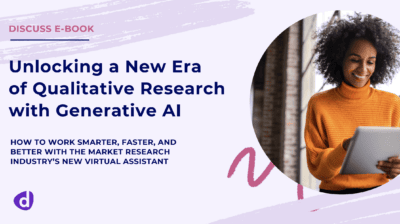Role of AI in Enhancing Qualitative Data Analysis

In today’s fast-paced world, wading through mountains of qualitative data can feel like searching for a needle in a haystack. However, Artificial Intelligence (AI) is emerging as a game-changer, automating tedious processes while uncovering insightful patterns at lightning speed. From NLP-powered algorithms that decode emotional undertones in text to intelligent systems sifting through vast amounts of user feedback with remarkable precision, AI reshapes how data analysts approach their work.
This transformation does not come without hurdles, though. It’s crucial to acknowledge common fears: difficulty of implementation and concerns over data privacy. Yet, with the right strategies and tools, these can be mitigated effectively. Drawing on case studies and expert insights gathered meticulously over time, we explore how state-of-the-art AI techniques are enhancing qualitative data analysis—setting a new standard for efficiency and depth in understanding consumer behavior and research trends.
AI enhances qualitative data analysis by automating the identification of themes, patterns, and insights from non-numeric data sources such as interview transcripts and multimedia files. It improves research efficiency through tools that offer natural language processing, sentiment analysis, and quick reporting capabilities, allowing researchers to focus on strategic interpretation rather than manual data sorting.
The Role of AI in Qualitative Data Analysis
Artificial Intelligence plays a pivotal role in qualitative data analysis by automating routine tasks and offering more profound insights from complex data sets. By leveraging AI, researchers can navigate through vast amounts of information with ease—something that traditional methods would take weeks or even months to accomplish.
One critical feature of AI in this context is Natural Language Processing (NLP), which enables the analysis of text and verbal data in a way that mirrors human understanding but operates at lightning speed.
Through NLP algorithms, AI can meticulously comb through open-ended responses and interview transcripts, pinpointing recurring themes and sentiments that offer significant insights into participant feedback. For instance, these algorithms can detect subtle emotional undertones, going beyond mere words to capture the nuances of feelings expressed in the text. This depth of analysis allows researchers to garner a comprehensive understanding of opinions, preferences, and concerns.
Imagine a product designer wanting to refine their latest gadget; an AI tool can analyze thousands of customer reviews to highlight common complaints or praises, helping the team focus on what truly matters.
As AI analyzes diverse data sources, it reduces human bias often prevalent in qualitative research.
Furthermore, this reduction in bias not only enhances the accuracy of findings but provides a more balanced view of participant perspectives. By relying on data-driven conclusions rather than subjective interpretations, researchers foster a more reliable foundation for their insights. With tools equipped to handle everything from survey results to social media interactions, the potential for AI applications becomes boundless.
It’s worth noting that while AI accelerates the analytical process, it does not completely replace human expertise. Instead, it acts as an invaluable companion that empowers researchers to focus on higher-level strategic decision-making rather than getting bogged down in manual analysis. By streamlining processes such as coding or sorting through large volumes of information, AI allows researchers to devote their time to crafting innovative solutions based on interpretation and contextual understanding.
In this exciting intersection of technology and human insight, exploring upcoming advancements will undoubtedly further enhance qualitative research methodologies.
Efficient Data Storage
Efficient data storage is crucial when it comes to qualitative data analysis. With the advent of artificial intelligence (AI) technologies, the amount of qualitative data being generated has skyrocketed. From social media posts and customer reviews to emails and surveys, researchers are now faced with vast amounts of unstructured data that needs to be organized and analyzed effectively. This is where efficient data storage plays a vital role in ensuring that researchers can access and process large volumes of data seamlessly.
Consider a market research firm that relies on qualitative data analysis to understand consumer preferences and trends. Without efficient data storage, they would be drowning in a sea of unorganized information. However, by implementing AI-powered solutions, such as natural language processing (NLP) algorithms and machine learning models, the firm can efficiently store and retrieve relevant data. For instance, by utilizing AI techniques to categorize and tag customer feedback based on sentiment analysis, the research team can easily identify patterns and insights that drive consumer behavior.
Moreover, efficient data storage not only saves time but also enhances accuracy in qualitative data analysis. Traditional methods of manually organizing and sifting through piles of documents or transcripts are not only labor-intensive but also prone to human error. AI-powered storage solutions allow for automated indexing, smart search capabilities, and real-time analytics. These advancements enable researchers to access specific information quickly and accurately, improving the overall efficiency of their analysis.
Some argue that relying too heavily on AI for data storage could lead to potential threats to privacy and security. They express concerns about unauthorized access or misuse of sensitive information stored in cloud-based systems. While these concerns are valid, it is important to note that advancements in AI have also led to improved security measures. Robust encryption algorithms and strict access controls can safeguard confidential data from unauthorized access.
Think of efficient data storage as the foundation of a well-organized library. Just like books need to be properly categorized and stored for easy access, qualitative data also requires a reliable system to ensure researchers can find relevant information efficiently. AI serves as the smart librarian, enabling quick searches, suggesting related resources, and even summarizing content for researchers. Without efficient data storage facilitated by AI, researchers would be left rummaging through stacks of unsorted information, wasting valuable time.
Efficient data storage is an essential aspect of qualitative data analysis empowered by AI. It not only provides researchers with the necessary infrastructure to handle large volumes of unstructured data but also enhances accuracy and enables faster insights. In the next section, we will explore the benefits of integrating AI into qualitative data analysis further.
Benefits of Integrating AI
The integration of AI into qualitative data analysis primarily enhances efficiency and accuracy. Imagine the way your workload would change if you had access to technology that could operate around the clock, without interruption or fatigue.
Picture having an indefatigable assistant—one who tirelessly scans and interprets vast datasets, freeing human researchers to concentrate on what truly matters: deriving strategic insights and making informed decisions. This shift offers a refreshing perspective on resource allocation, allowing researchers to elevate their work beyond mere data analysis and into deep-dive evaluations of findings.
Key Benefits
One of the most prominent perks of integrating AI lies in its ability to drastically enhance speed. By automating repetitive tasks such as coding open-ended responses or categorizing feedback, AI can substantially shorten the turnaround time for analysis. This means valuable insights can be gleaned more quickly, enabling timely decision-making in fast-paced environments.
Furthermore, there’s the aspect of cost-effectiveness. With reduced reliance on manual labor for tedious tasks, organizations can significantly lower costs associated with these lengthy processes. Think about the savings in terms of both time and money when fewer staff hours are required to manage data.
Another important benefit is scalability. AI has the unmatched capability to handle vast quantities of data simultaneously—a feat that traditional manual methods struggle to achieve. Whether it’s hundreds or thousands of survey responses, AI systems can process and analyze it without a hitch, paving the way for richer datasets that yield deeper insights.
Human-AI Synergy
This collaboration goes beyond mere tool usage; it thrives on mutual enhancement where both human intuition and AI capabilities bolster one another. Think of AI as a powerful ally — one that can process vast amounts of data quickly and accurately, while researchers bring experience, critical thinking, and emotion to the table. Together, they achieve insights that neither could accomplish alone.
When researchers use AI tools, they unlock efficiencies that allow time for deeper analyses. Take customer feedback as an example; while AI analyzes countless reviews in seconds to spot trends like an increase in complaints regarding product durability, human insight comes into play to ask why these feelings exist. Are there manufacturing issues? Are consumers feeling more vocal about their experiences due to social media influence? These contextual questions are vital for crafting effective strategies.
Steps to Effective Human-AI Collaboration
To ensure this synergy is not just theoretical but practical, several steps should be implemented within research environments:
- Training: Researchers must be adequately trained to use AI tools effectively. This means understanding how algorithms work and their limitations. Knowledge breeds confidence, making researchers more adept at leveraging AI’s strengths.
- Interpretation: After AI presents initial findings, experienced researchers should review and interpret these results for contextual relevance. It’s crucial that conclusions drawn from data do not ignore nuances that only a human perspective can provide.
- Feedback Loop: Establishing a feedback loop where human insights refine AI algorithms leads to continuous improvement. By engaging directly with the data-producing process, researchers inform future iterations of AI technology to become smarter and more accurate.
- Ethical AI Use: Ethical considerations when using AI tools cannot be overstated. Transparency in methodology builds trust among stakeholders—ensuring participants understand how their data will be processed and analyzed bolsters integrity in research practices.
As we navigate the evolving landscape of research methods, a commitment to enhancing these collaborative approaches will redefine our understanding of qualitative data analysis and its future potential.
Future Trends and Prospects
As AI technology continues to advance, we can expect a significant shift in the realm of qualitative data analysis. One of the most notable trends will be increased automation. This means that tasks previously requiring human effort, such as transcription or thematic analysis, will increasingly be handled by sophisticated AI algorithms. Imagine walking into your office, uploading a batch of interviews from last night’s focus group, and within moments receiving automatically generated insights. The potential for efficiency here is immense.
Alongside automation, there will be an enhanced multimedia analysis capability. Currently, researchers often find themselves analyzing text-based data while struggling to extract deeper meaning from audio and video material. Future AI systems are expected to excel at processing this type of content, identifying key themes and emotional cues that may not be easily captured through textual analysis alone. For instance, an AI might analyze a video interview and pick up on subtle body language signals that indicate participant bias or uncertainty.
This leads us to consider the implications of real-time analysis.
Future advancements are likely to introduce tools capable of immediate feedback during research sessions. Imagine conducting an interview and receiving live prompts from an AI tool suggesting questions based on detected emotional responses or inconsistencies in a participant’s narrative. This capability would not only enrich the quality of data collected but also enhance the overall workflow of research teams.
Furthermore, a push for greater accessibility cannot be overlooked. As AI-powered analysis becomes more user-friendly and cost-effective, even small organizations with limited budgets will gain access to tools that were once exclusive to larger institutions. They’ll enable diverse perspectives in research topics ranging from community health to education reforms.
A crucial aspect to consider is that as organizations increasingly rely on AI for both qualitative and quantitative data analysis, traditional approaches might be challenged. Existing strategies that have long been utilized may need reconsideration as we learn more about leveraging these tools effectively.
Thus, it’s essential for researchers and policymakers alike to remain adaptable as these trends unfold in the next few years.
Organizations will transform how insights are derived from data leading up to more informed decision-making processes grounded in comprehensive analyses rather than fragmented observations. Embracing AI does not herald the end of human interpretation; instead, it signifies a new partnership where we can work alongside machines to uncover truths hidden within our data landscape.
For more insights into cutting-edge AI tools and techniques for qualitative data analysis, make sure to visit Discuss where this ongoing dialogue about technology and research continues to grow. Engaging with these advancements will empower you to harness the full potential of qualitative research like never before.
Sign Up for our Newsletter
Related Articles

Discuss Employee Spotlight – Adam
The “Discuss Employee Spotlight” is a Q&A series dedicated to showcasing all of the amazing talent at Discuss. For this…
The “Discuss Employee Spotlight” is a Q&A series dedicated to showcasing all of the amazing talent at Discuss. For this…

Qualitative Data Analysis: Best Practices for Accurate Insights
Choosing the right analytical methods is essential to making headway with your data. Countless hours of reviewing academic papers and…
Choosing the right analytical methods is essential to making headway with your data. Countless hours of reviewing academic papers and…

Top Techniques for Effective Qualitative Data Analysis: Tools and Methods
Struggling to make sense of endless interview transcripts or piles of survey responses? You’re not alone. Many researchers find themselves…
Struggling to make sense of endless interview transcripts or piles of survey responses? You’re not alone. Many researchers find themselves…


